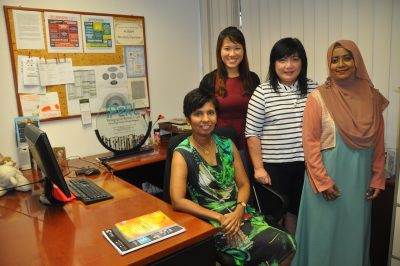Why Singapore’s English Teachers Should Embrace Singlish, Not Fight It
Is it time for Singaporean educators to embrace Singlish as a legitimate learning tool? What the Research […]
Read More
Contributed by Masturah Binte Abdul Aziz and Tan Yen Chuan, Centre for Pedagogical Research and Learning, Raffles Girls’ School, for SingTeach Issue 61.
As teachers, we always wonder: Beyond the grades, how do we know our students are learning? How have we made a difference to their learning? The Professional Learning Community (PLC) plays a big role to help address these questions. It functions as a learning platform which enables teachers to learn from each other and develop more effective ways of doing things.
In this article, Ms Masturah and Ms Tan Yen Chuan from the Raffles Girls’ School Centre for Pedagogical Research and Learning (PeRL) uncover teachers’ thinking processes in the PLC and delve into how teachers can leverage the PLC to better understand their students’ learning needs.

(Seated) Mary George Cheriyan (Deputy Principal, Centre of Pedagogical Research and Learning [PeRL] and Community Engagement). (Standing, from left) Tan Yen Chuan (Teacher-Specialist), Lucille Yap (Head, Consultancy), Masturah Binte Abdul Aziz (Senior Research Executive)
According to DuFour (2004), an effective PLC is one which engenders a focus on student learning, engages teachers in collaborative work, and encourages accountability for results.
RGS uses its own adapted framework, the Create-Implement-Review (CIR) cycle, to guide the discourse within the PLC (see figure 1 below). Central to this cycle is the focus on evidence of student learning.
Using this framework, we examined the extent to which the PLC guided teacher practices towards established standards set by the school and how these practices have contributed to student achievement.

Figure 1. The Create-Implement-Review (CIR) framework which guides professional discourse in the PLC.
We found that the PLC played a strong role in supporting various areas of teachers’ knowledge and practices.
For example, teachers actively participated in the design of unit/lesson plans, which helped align their teaching goals to classroom practice. They also rigorously discussed Higher Order Thinking (HoT) teaching strategies to engage and challenge learners.
“We take turns designing the lesson plans and after the lesson ends, we would discuss our experiences. What’s the feedback on the lesson plan and how can we improve on the teaching?”
– Quote from Teacher A
Teachers also took collective ownership in establishing teaching standards specific to the discipline. This included refining assessment practices such as integrating formative and summative assessments effectively into classroom teaching and learning.
According to Guskey (1997), successful professional development efforts center primarily on issues related to learning and the learners. We found that the potential of the PLC for improving student outcomes could be further tapped. One question we should always ask in the PLC is, “How do we, as teachers, respond to student learning?”
This “responsiveness” may include being able to identify the individual differences among students, cater to their individual learning needs, and address students’ difficulties in understanding what they are being taught.
Although the CIR framework emphasizes evidence of student learning in the PLC, we found that only half of the teachers surveyed felt that the PLC had a positive effect on their responsiveness to student learning.
We recommend some strategies to increase the effect of the PLC on students’ learning outcomes.
1) Skilful facilitators are important in leading meaningful PLC discussions. Senior teachers or Head of Departments can play a bigger role to consciously engage teachers in more professional conversations that zone in on student learning in the PLC.
2) Some structure is necessary to lead the direction of the PLC to its intended outcomes. The Professional Development Department could cascade some guiding questions for the department leaders to facilitate professional conversation towards a learner-centred and data-driven PLC.
The table below shows how some questions asked during PLC discussions can be modified to have a more learner-centred focus.
3) Assessment data play an important role in driving student achievement. There are different types of data such as diagnostic tests and assessment scores that can be collected to analyse student learning. Other evidences that can be used to address students’ learning are samples of students’ work, such as portfolios and reflections.
Some PLC groups had taken initial steps to use student assessment data as part of their discussions. These groups had greater insights into their students’ learning, and used the data to inform their practice.
“As practitioners, because you are teaching, you are most familiar with it on the ground.. and you’ve got to understand what’s happening as well. Analyzing the assessment data might generate more information for you to make a certain decision.”
– Summarized by Teacher B
According to Bolam et al. (2005), a key purpose of the PLC is to increase teachers’ effectiveness as professionals with the goal to enhance students’ learning.
With full school support and a collaborative culture, the PLC is able to facilitate development of teachers’ knowledge and practices and support the translation of knowledge gained into practice.
In order to sustain the effectiveness of a PLC in growing teacher capacities, it is important to always keep in mind the central goal of any professional learning initiative: the learner.
References
Bolam, R., et al. (2005). Creating and sustaining effective professional learning communities. Bristol, UK: University of Bristol Department of Education and Skills.
DuFour, R. (2004). What is a” professional learning community”? Educational Leadership, 61(8), 6–11.
Guskey, T. R. (1997). Research needs to link professional development and student learning. Journal of Staff Development, 18, 36–41.
Acknowledgements
The authors would like to acknowledge the colleagues in the Centre for Pedagogical Research and Learning (RGS PeRL), in particular Head of Consultancy, Mrs Lucille Yap and Deputy Principal, Mrs Mary George Cheriyan, for their contributions leading to the completion of this research project. The authors would also like to convey their gratitude to Professor Anne Lin Goodwin, Evenden Professor of Education and Vice Dean, Teachers College, Columbia University, for her guidance in this project.